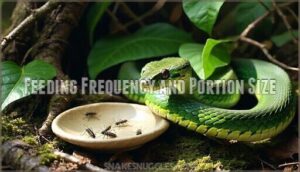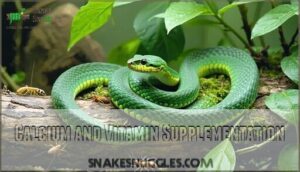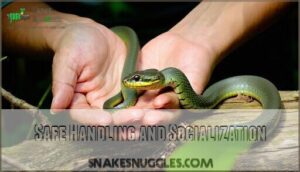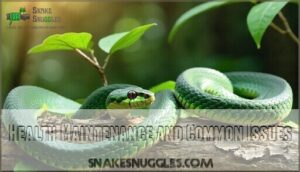This site is supported by our readers. We may earn a commission, at no cost to you, if you purchase through links.

These southeastern natives demand high humidity, UVB lighting, and climbing branches to thrive, living up to 15 years when their wetland-like conditions are properly replicated.
Their bright green camouflage and gentle temperament make them appealing, but don’t let their calm nature fool you—they’re surprisingly particular about temperature gradients and stress easily without proper environmental complexity.
The secret lies in understanding their diurnal hunting patterns and creating the right microclimate to ensure they have the best chance of thriving in captivity with the right care.
Table Of Contents
- Key Takeaways
- Rough Green Snake Overview
- Behavior and Temperament
- Lifespan and Longevity
- Enclosure Setup and Space Requirements
- Temperature, Lighting, and Humidity
- Diet and Feeding Guidelines
- Safe Handling and Socialization
- Health Maintenance and Common Issues
- Responsible Ownership and Conservation
- Frequently Asked Questions (FAQs)
- Conclusion
Key Takeaways
- You’ll need specialized arboreal setups – Create vertical climbing spaces with branches reaching 75% of enclosure height, UVB lighting, and maintain 50-75% humidity to replicate their natural wetland canopy lifestyle.
- Temperature gradients are crucial – Establish a 90°F basking spot with 72-80°F cool zones, allowing nighttime drops to 70°F using halogen bulbs, never ceramic emitters.
- They’re surprisingly delicate and stress-prone – Limit handling to 10-15 minutes maximum, move slowly to avoid triggering flight responses, and provide environmental complexity with dense foliage and multiple perches.
- Diet requires soft-bodied insects only – Feed juveniles daily and adults every 2-3 days with gut-loaded crickets, caterpillars, and spiders dusted with calcium supplements, avoiding hard-shelled insects that cause impaction.
Rough Green Snake Overview
You’ll find the rough green snake (Opheodrys aestivus) to be one of North America’s most striking reptiles, with its vibrant emerald coloration and graceful arboreal lifestyle making it a fascinating species for experienced keepers.
This slender, keeled-scaled serpent reaches 2-3 feet in length and thrives in the wetland forests of the southeastern United States, where its bright green camouflage perfectly matches the foliage it calls home, allowing it to live a fascinating life.
Scientific Name and Classification
The rough green snake belongs to the scientific classification Opheodrys aestivus, representing a distinct snake species within North American herpetology.
This taxonomic history reveals fascinating evolutionary relationships among colubrid snakes, though subspecies debate continues among researchers.
The naming etymology reflects the snake’s characteristic rough, keeled scales that distinguish it from smooth relatives.
Modern identification keys rely on scientific analysis of scale patterns, coloration, and morphological features for accurate snake care and field identification purposes.
Their vibrant coloration offers excellent natural camouflage.
Native Range and Natural Habitat
You’ll find these adaptable snakes throughout the southeastern United States and northwestern Mexico, where they’ve mastered life in wetland ecosystems.
These remarkable snakes have transformed wetland canopies into their personal highways, mastering arboreal life with stunning grace
Their geographical distribution spans from coastal marshes to woodland ponds, making snake habitat selection critical for successful snake care.
These arboreal lifestyle specialists thrive in forested areas with high snake humidity and moderate snake temperature ranges, though their conservation status remains stable despite collection pressures.
Physical Characteristics and Identification
The rough green snake reaches 2-3 feet in length, displaying a slender body shape with distinctive keeled scale patterns.
You’ll recognize its bright yellow-green dorsal coloring and cream underside – color variations are minimal in this species.
Size differences between rough and smooth green snakes help identification, with rough greens being markedly larger.
Key distinguishing features include the oval-shaped head and round pupils that define this arboreal species.
Behavior and Temperament
Understanding rough green snake behavior helps you create the right environment for these graceful, tree-dwelling reptiles.
These snakes are naturally calm but require specific conditions to reduce stress and encourage their active, climbing lifestyle.
Arboreal and Diurnal Habits
Your snake’s day starts when the sun rises, making rough green snakes active climbers during daylight hours.
Their exceptional visual acuity helps them navigate complex branch networks in their natural environment.
This daytime activity pattern means you’ll need proper snake lighting to support their active climbing behavior.
A well-designed snake enclosure with habitat complexity mirrors their arboreal lifestyle, encouraging natural reptile care through environmental enrichment that promotes healthy snake behavior, which is supported by proper snake lighting.
Interaction With Humans
While these snakes prefer their leafy hideaways to human company, you’ll find they can become surprisingly tolerant pets with patience.
However, they’re not cuddle buddies, and their delicate nature means gentle handling is non-negotiable.
Here’s what you need to know about human interaction:
- Handling Stress builds quickly – limit sessions to 5-10 minutes maximum to prevent health issues
- Bite Risk remains minimal since they’re non-venomous, but their tiny teeth can still pinch
- Children Safety requires constant adult supervision due to the snake’s fragile build and escape-artist tendencies
Stress and Enrichment Needs
These arboreal acrobats need Environmental Complexity to thrive, mimicking their natural canopy lifestyle.
Create climbing opportunities with branches reaching different heights, dense foliage for hiding, and varied textures.
Reducing Stress involves limiting Handling Frequency to essential maintenance only.
Natural Behaviors flourish when you provide live plants, multiple perches, and quiet observation spaces.
Enrichment Ideas include rotating decorations monthly, offering different branch diameters, and maintaining consistent routines for snake water, snake food, and general snake health monitoring.
To alleviate stress, consider providing secure hide locations to support the well-being of your snakes.
Lifespan and Longevity
When you provide proper care, your rough green snake can live upwards of 15 years in captivity, offering you many years of enjoyment watching this graceful arboreal species.
However, their longevity depends heavily on maintaining a stress-free environment with appropriate habitat conditions, as these delicate snakes are particularly sensitive to poor husbandry practices.
Expected Lifespan in Captivity
Your rough green snake typically lives 6-8 years in captivity, though exceptional care can extend this to 10 years.
With proper care, your rough green snake can thrive for up to a decade in captivity
Captivity factors like consistent environmental conditions substantially impact longevity, while genetic influence plays a smaller role.
Diet quality and stress reduction remain vital for snake health and lifespan extension.
Captive snakes often benefit from elimination of predators, leading to extended lifespans.
Key longevity factors include:
- Ideal temperature gradients preventing respiratory infections
- Weekly dietary variety boosting average lifespan by 2 years
- UVB lighting supporting natural snake shedding cycles
- Stress-free environments reducing premature mortality by 40%
- Regular veterinary exams catching health issues early
Factors Affecting Longevity
Several factors substantially influence your rough green snake’s lifespan, with stress reduction being paramount for longevity.
Genetic predisposition plays a role, but you can’t control snake morphs or snake breeding history.
However, you can impact snake lifespan through proper snake diet, environmental enrichment, and veterinary access.
Snake size often correlates with age, so monitoring growth helps assess health.
Consistent temperature, humidity, and dietary impact from quality nutrition create ideal conditions.
Remember, these delicate creatures thrive when their stress levels stay low.
Enclosure Setup and Space Requirements
You’ll need a spacious, tall enclosure to accommodate your rough green snake’s arboreal lifestyle and climbing needs.
A minimum 20-gallon long tank works for one adult, though larger setups like 55-75 gallon terrariums provide better space for multiple snakes and extensive climbing opportunities.
Recommended Enclosure Size
Your snake’s home needs thoughtful sizing to support its arboreal lifestyle.
A single adult requires minimum 36" x 18" x 24" dimensions, with vertical space being non-negotiable for climbing behaviors.
Cohabitation concerns multiply space requirements by 50% per additional snake.
Juvenile enclosures start smaller but maintain height priorities.
Proper sizing addresses enrichment needs while supporting escape prevention through adequate territory provision.
Ideal Enclosure Design and Security
Choose front-opening enclosures with hinged doors over sliding or top-opening designs for better escape prevention.
Vertical space matters more than floor area since these arboreal snakes spend most time climbing.
Install secure screen lids and check all gaps carefully—juveniles can squeeze through surprisingly small openings.
Consider a suitable habitat supplier for enclosure needs.
Design your setup with plant integration in mind, leaving room for climbing branches that reach 75% of the enclosure height.
Substrate and Furnishings for Climbing
Since rough green snakes are arboreal by definition, meaning they’re natural climbers, you’ll need safe substrates like gravel or small stones for easy cleaning and parasite prevention.
Create vertical space with climbing branches reaching 75% of the enclosure height, add plant choices for hiding spots, and remember that proper furnishings make snake handling easier by reducing stress.
Supplementing their environment with appropriate climbing structures is essential for their well-being.
Temperature, Lighting, and Humidity
Creating the right environmental conditions for your rough green snake requires precise attention to temperature, lighting, and humidity levels.
These arboreal species depend on specific parameters to maintain their health, digest food properly, and display natural behaviors throughout their 15-year lifespan.
Creating a Proper Temperature Gradient
Temperature definition means establishing distinct thermal zones that mimic your snake’s natural environment.
Creating proper heat gradients requires strategic thermometer placement and careful analysis of temperature conditions throughout the enclosure.
- Basking Spot: Maintain 90°F using low-wattage halogen heat sources
- Cool Zone: Keep temperatures between 72-80°F for thermoregulation
- Night Drop: Allow temperatures to decrease to 70°F naturally
- Heat Sources: Avoid ceramic emitters; use halogen bulbs only.
These bulbs are available at various online retailers.
UVB Lighting and Photoperiods
UVB Benefits transform your snake’s health through vitamin D3 synthesis and improved calcium metabolism.
Position bulbs 6-11 inches above basking branches using Zoo Med T8 Reptisun 5.0 or Arcadia ShadeDweller kits.
Photoperiod Schedules require 13 hours summer, 11 hours winter for Seasonal Variation.
This scientific analysis shows proper Bulb Placement prevents metabolic bone disease, defining ideal Health Impacts for your arboreal companion.
Providing UVB lighting is fundamental to responsible snake care.
Humidity Levels and Monitoring
Maintaining proper humidity levels creates a rough condition that’s difficult to achieve without careful monitoring.
You’ll need humidity between 50-75%, measured with a digital hydrometer placed away from water sources.
Mist the enclosure 1-2 times daily, providing humid hides filled with sphagnum moss.
This surface moisture aids shedding and prevents dehydration-related health issues.
Proper ventilation is key to preventing scale rot and infections.
Diet and Feeding Guidelines
Feeding your rough green snake correctly involves understanding their insectivorous diet and specific nutritional requirements.
You’ll need to provide soft-bodied insects while carefully managing portion sizes and supplementation to keep your snake healthy.
Suitable Prey and Nutritional Needs
Your rough green snake’s diet revolves around soft-bodied insects like crickets, caterpillars, and spiders.
Insect gut-loading improves nutritional value, while proper prey size matches your snake’s head width.
Hard-shelled insects pose impaction risks, so focus on softer examples.
Calcium supplementation methods prevent deficiency, maintaining ideal body condition and healthy appearance through balanced feeding schedules and ensuring proper nutritional value with soft-bodied insects.
Feeding Frequency and Portion Size
When feeding your rough green snake, timing matters more than you might think.
Juvenile feeding schedules differ substantially from adult portions, creating a feeding rhythm that mimics their natural hunting condition.
- Juvenile Feeding: Feed daily with 1-2 appropriately sized insects
- Adult Portions: Offer 2-3 insects every 2-3 days for ideal health
- Prey Size: Match insects to your snake’s girth for easy digestion
- Insect Gutloading: Load feeders 24 hours before offering for maximum nutrition
- Supplement Frequency: Dust insects before each feeding for consistent vitamin intake
Calcium and Vitamin Supplementation
Supplementing your rough green snake’s diet with calcium and vitamins is essential for preventing metabolic bone disease.
Dust feeder insects with Repashy Calcium Plus LoD before each feeding, following supplement schedules that prevent over supplementation.
Gut loading insects with nutritious foods enhances calcium sources and vitamin D3 absorption, supporting your snake’s long-term health and vitality.
Safe Handling and Socialization
Handling your rough green snake requires patience and gentle techniques, as these delicate creatures stress easily and can be injured by improper grip pressure.
You’ll need to move slowly and support their body weight while allowing them to feel secure, which helps build the trust necessary for successful long-term care.
Proper Handling Techniques
Beyond nutrition, your rough green snake’s physical well-being depends on gentle, stress-free interactions. These delicate creatures require careful handling techniques that respect their nervous nature and fragile build.
Here are five essential handling guidelines:
- Support the snake’s body completely – Never grab just the head or tail, as this causes injury and panic
- Move slowly and deliberately – Quick movements trigger their flight response, increasing stress levels substantially
- Use handling tools when necessary – Snake hooks help maintain safe distance during enclosure maintenance
- Limit handling sessions to 10-15 minutes – Extended contact overwhelms these sensitive reptiles
- Avoid handling during shedding periods – Their skin becomes tender and vulnerable to damage
Snake wrapping around your arm is normal behavior, not aggression. The rough texture of their keeled scales provides excellent grip.
Safety precautions include washing hands before and after contact to prevent disease transmission. Remember, violence or forceful movements will damage trust permanently.
Building Trust and Reducing Stress
Gentle handling builds the foundation for stress reduction in your rough green snake, but trust building requires patience and consistency.
These delicate snakes can find even minor disturbances difficult to handle, so your approach matters substantially.
Environmental enrichment plays a key role in creating calming conditions that support natural behaviors.
| Trust Building Phase | Timeline | Techniques |
|---|---|---|
| Initial Quarantine | 2-4 weeks | Minimal handling, observe feeding |
| First Contact | Week 5-6 | Brief, gentle sessions (2-3 minutes) |
| Regular Interaction | Week 7-12 | Gradual increase in handling time |
| Established Trust | Month 4+ | Confident, stress-free interactions |
| Maintenance | Ongoing | Consistent, respectful handling |
Violence or harsh movements will set back your progress considerably, so move slowly and deliberately during all interactions.
Health Maintenance and Common Issues
Keeping your rough green snake healthy requires vigilance since these delicate creatures can develop serious issues quickly if their environment isn’t just right.
You’ll need to watch for subtle signs of illness, maintain proper hydration levels, and establish a relationship with an exotic veterinarian who understands their unique needs.
Signs of Illness and Parasite Control
Building trust through proper handling won’t mean much if your snake’s health takes a rough turn. Recognizing illness early makes the difference between quick recovery and difficult veterinary battles.
Watch for these warning signs that signal your green friend needs immediate attention, as uneven breathing patterns often indicate serious respiratory issues. Proper snake care guide is essential to prevent many of these health issues.
- Dehydration signs – sunken eyes, wrinkled skin, and lethargy
- Respiratory issues – open-mouth breathing, wheezing, or nasal discharge
- Parasite control – excessive soaking, rubbing, or visible mites crawling
- Malnutrition symptoms – weight loss, poor growth, chronic food refusal
- Impaction risks – abdominal swelling, regurgitation, or harsh straining during defecation
Hydration and Preventing Dehydration
Proper hydration keeps your rough green snake healthy and prevents serious complications.
Fresh, clean water must be available daily in shallow dishes, as these snakes have specific drinking habits and require consistent moisture control.
Watch for dehydration signs like sunken eyes, wrinkled skin texture, or lethargy.
Maintain humidity levels between 50-75% through daily misting, which supports both drinking behavior and overall water quality in the enclosure, ensuring proper hydration.
Routine Veterinary Care
Everyone knows that ongoing veterinary checks can mean the difference between catching health issues early and facing harsh medical emergencies down the road.
Establishing routine care helps monitor your rough green snake’s physical attributes and prevents difficulty with parasite control.
There are several key components to this care, including:
- Annual health exams with exotic veterinarians
- Fecal testing every six months for parasites
- Emergency surgical care protocols when needed
Responsible Ownership and Conservation
Owning a rough green snake comes with important legal and ethical responsibilities that you can’t ignore.
You’ll need to check local regulations, support conservation efforts, and choose captive-bred animals to help protect wild populations from continued exploitation, which involves significant responsibilities.
Legal Considerations and Permits
You’ll need permits in most states to legally own rough green snakes, with over 60% requiring wildlife possession documentation.
Federal regulations through the Lacey Act govern interstate transport, while state-specific laws vary substantially.
Some states ban wild collection entirely, requiring scientific permits instead, and permit fees range from $10-100, and violations can result in $10,000 fines or equipment seizure.
Conservation Efforts and Ethical Sourcing
Your rough green snake’s purchase supports either wildlife protection or harmful collection practices, making ethical sourcing vital for species preservation.
Responsible buyers choose captive-bred specimens from verified breeders who prioritize habitat conservation and sustainable trade practices.
Here’s how to guarantee eco-friendly practices:
- Request breeding documentation – Verify your snake comes from established captive breeding programs, not wild collection
- Support conservation groups – Purchase from dealers who donate to habitat conservation and wildlife protection initiatives
- Choose local breeders – Reduce transportation stress while supporting sustainable trade in your region
- Avoid cheap imports – These often indicate rough collection methods that harm outdoor ecosystems
Supporting Sustainable Practices
When you support sustainable breeding programs instead of wild-caught rough green snakes, you’re helping protect nature’s delicate ecosystems.
Choose eco-friendly suppliers who prioritize wildlife conservation over profit margins.
Your purchasing decisions directly impact environmental sustainability, encouraging green practices that reduce the outdoor collection of these beautiful creatures from their natural habitats.
Frequently Asked Questions (FAQs)
How often do rough green snakes shed their skin?
Young snakes shed monthly, adults every two to three months. You’ll notice cloudy eyes and dull coloring before shedding begins, signaling it’s time for their natural renewal process.
Can rough green snakes be bred in captivity?
Yes, you can breed rough green snakes in captivity, though it’s challenging. They need specific temperature cycling, proper nutrition, and stress-free environments to reproduce successfully in home setups.
What tank mates are compatible with them?
Housing multiple species together can be absolutely disastrous! You shouldn’t keep tank mates with rough green snakes, as cohabitation with other species increases stress, disease transmission, and territorial conflicts substantially.
How much do rough green snakes cost initially?
You’ll typically pay around eight dollars wholesale for rough green snakes, making them quite affordable initially. However, factor in setup costs for proper enclosures, lighting, and supplies.
Do they require special permits to own?
Like traversing uncharted waters, permit requirements vary dramatically by state and locality.
You’ll need to check your specific area’s regulations, as some states prohibit wild-caught reptiles while others allow them freely.
What signs indicate successful acclimation to captivity?
Successful acclimation signs include regular feeding without refusal, normal activity levels with frequent climbing.
Healthy shedding cycles, calm behavior when observed, and consistent waste production indicating proper digestion and stress reduction.
The signs indicate proper digestion and overall well-being.
Conclusion
Mastering rough green snake husbandry isn’t rocket science, but it demands attention to detail that separates successful keepers from those who struggle.
By following this rough green snake care sheet approved by a herpetologist, you’ll create the arboreal paradise these delicate reptiles need to flourish.
Remember, consistency in temperature gradients, humidity levels, and environmental enrichment makes all the difference.
Your dedication to proper care will reward you with a healthy, vibrant snake that can live its full 15-year lifespan in captivity.
- https://www.flickr.com/photos/71701055/5681822338
- https://creativecommons.org/licenses/by-nc-nd/2.0/?ref=ccsearch&atype=rich
- https://reptilesupply.com/blogs/snake-care-sheets/how-to-care-for-your-rough-green-snake
- https://www.critterishallsorts.co.uk/wp-content/uploads/2012/04/rough-green-snake-care-sheet.pdf
- https://showmereptileshow.com/resources/creating-a-natural-environment-for-snakes-the-importance-of-uvb-lighting


















